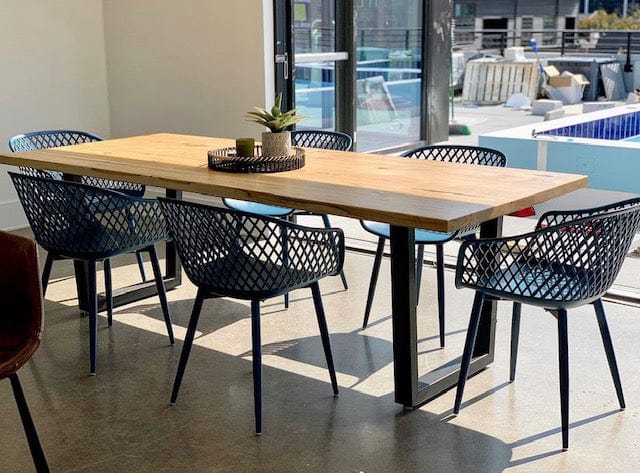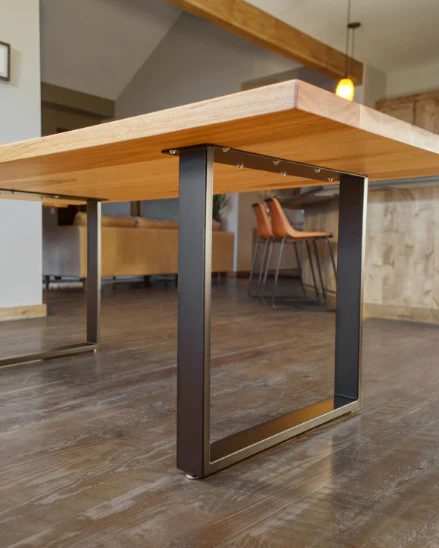The Top Trends in Dining Room Table Legs You Need to Know
The Top Trends in Dining Room Table Legs You Need to Know
Blog Article
From Conventional to Modern: Locate the Suitable Dining Room Table Legs for Your Style
The choice of eating area table legs plays an essential role in specifying the overall personality of your room, connecting the gap between traditional craftsmanship and modern aesthetics. While timeless styles such as cabriole and turned legs stimulate a sense of timeless refinement, modern designs like hairpin and geometric alternatives present a possibility for striking visual interest. Examining the right balance between these styles requires a nuanced understanding of your existing decor and individual taste. As you consider these elements, the inquiry stays: exactly how can you perfectly integrate these varied leg designs to produce an unified dining experience?
Understanding Table Leg Styles
The variety of dining-room table leg styles can substantially affect both the appearances and capability of the room. Each leg style contributes unique visual aspects and functional features, satisfying diverse layout choices and usage demands. Comprehending these designs is vital for selecting the right table that straightens with your general indoor style vision.
For circumstances, conical legs use a tidy, timeless look that can boost a space's sophistication, while pedestal bases give security and optimize legroom, making them perfect for smaller sized rooms. Barrette legs, a characteristic of mid-century modern style, introduce an industrial panache, permitting an airy, open feel. In a similar way, trestle legs evoke rustic beauty, providing robust assistance and a feeling of timelessness.
Wood legs can bring warmth and texture, whereas metal options commonly communicate a sleek, contemporary vibe. Ultimately, comprehending table leg styles is essential for creating a natural eating area that shows personal design while guaranteeing usefulness and convenience.
Conventional Table Leg Options
When selecting dining space table legs, conventional options frequently personify classic elegance and workmanship. These layouts reflect an abundant heritage and a commitment to top quality, making them ideal for those that value timeless visual appeals.
One of the most famous standard leg styles is the cabriole leg, defined by its graceful rounded form. This layout typically includes decorative carvings and is most typically discovered in Queen Anne and Chippendale furniture. Another popular choice is the transformed leg, which boasts a collection of smooth, rounded shapes that supply a traditional appearance while keeping security.
Furthermore, the straight leg, while easy, uses a strong and unadorned structure that can blend effortlessly with a range of tabletop styles. For those drawn to ornate outlining, claw-and-ball feet legs evoke a feeling of splendour and can serve as a sensational centerpiece in any type of dining area.
Last but not least, stand bases, although not strictly legs, give a different traditional alternative that enables sufficient legroom and can be magnificently sculpted. Each of these traditional leg designs adds to the total atmosphere of an eating room, weding feature with visual charm.

Modern Table Leg Styles
Modern table leg layouts use a varied variety of designs that emphasize clean lines and innovative products. These layouts usually focus on capability while offering as striking focal points within a dining area. Minimal visual appeals are widespread, with legs crafted from products such as metal, glass, and engineered timber, which contribute to a modern and airy feeling.
One popular design is the barrette leg, defined by its slim, conical framework that supplies stability without frustrating the tabletop (dining room table legs). This style is commonly discovered in mid-century contemporary furnishings and can easily match different dining table shapes. One more pattern is the use of geometric forms, where legs may take on angular or unbalanced types, adding aesthetic passion and a touch of virtuosity

Mixing Designs for One-of-a-kind Rooms
Usually, home owners look for to develop one-of-a-kind dining areas that reflect their individual style by mixing various style aspects. This technique enables the consolidation of varied appearances, resulting in an unified yet distinctive setting. As an example, pairing a rustic wood table with smooth, contemporary metal legs can produce a captivating contrast that raises the space's general charm.
Furthermore, incorporating vintage table legs with contemporary table tops can stimulate a feeling of background linked here while maintaining a modern-day perceptiveness. check out this site Such combinations not only showcase individual taste yet likewise motivate creativity, permitting home owners to curate a room that really feels both individual and inviting.
Shade plays a critical role in this blending procedure; selecting table legs that complement or contrast with the existing color pattern can boost aesthetic rate of interest. For example, whitewashed legs can soften the boldness of a dark table surface, producing a balanced aesthetic.
Tips for Picking the Right Legs
Selecting the right table legs is crucial for accomplishing both capability and aesthetic appeal in your eating area. Begin by considering the overall design of your area. Typical settings benefit from legs that include detailed carvings or transformed designs, while modern areas might ask for smooth, minimalist styles.
Next, assess the height and stability of the legs. dining room table legs. Basic table vary in between 28 to 30 inches in height, so ensure the legs match this measurement for comfort. Furthermore, durable materials, such as wood or metal, can improve security and long life
Review the leg shape too-- choices consist of right, tapered, or pedestal designs. Straight legs supply a traditional look, while tapered legs can add a touch of elegance. Pedestal bases supply ample legroom and are suitable for smaller sized areas.
Verdict
In recap, selecting the ideal eating area table legs calls for careful consideration of both traditional and modern styles. By harmonizing leg style, elevation, and product with the general decoration, a cohesive and inviting environment can be accomplished.
The variety of eating room table leg styles can considerably affect both the aesthetic appeals and capability of the area. Ultimately, comprehending table leg designs is necessary for producing a cohesive dining location that shows individual style while making sure practicality and comfort.One of the most legendary conventional leg designs is you could try here the cabriole leg, characterized by its stylish bent shape. Straight legs supply a classic appearance, while conical legs can add a touch of elegance.In recap, picking the optimal eating space table legs needs careful factor to consider of both modern and standard designs.
Report this page